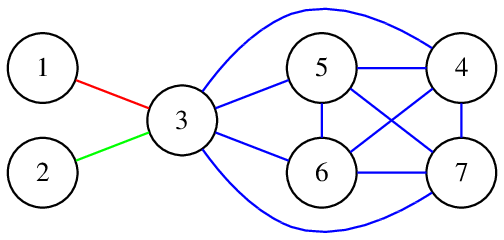| Grakn Forces 2020 |
|---|
| Finished |
You are given $$$m$$$ sets of integers $$$A_1, A_2, \ldots, A_m$$$; elements of these sets are integers between $$$1$$$ and $$$n$$$, inclusive.
There are two arrays of positive integers $$$a_1, a_2, \ldots, a_m$$$ and $$$b_1, b_2, \ldots, b_n$$$.
In one operation you can delete an element $$$j$$$ from the set $$$A_i$$$ and pay $$$a_i + b_j$$$ coins for that.
You can make several (maybe none) operations (some sets can become empty).
After that, you will make an edge-colored undirected graph consisting of $$$n$$$ vertices. For each set $$$A_i$$$ you will add an edge $$$(x, y)$$$ with color $$$i$$$ for all $$$x, y \in A_i$$$ and $$$x < y$$$. Some pairs of vertices can be connected with more than one edge, but such edges have different colors.
You call a cycle $$$i_1 \to e_1 \to i_2 \to e_2 \to \ldots \to i_k \to e_k \to i_1$$$ ($$$e_j$$$ is some edge connecting vertices $$$i_j$$$ and $$$i_{j+1}$$$ in this graph) rainbow if all edges on it have different colors.
Find the minimum number of coins you should pay to get a graph without rainbow cycles.
The first line contains two integers $$$m$$$ and $$$n$$$ ($$$1 \leq m, n \leq 10^5$$$), the number of sets and the number of vertices in the graph.
The second line contains $$$m$$$ integers $$$a_1, a_2, \ldots, a_m$$$ ($$$1 \leq a_i \leq 10^9$$$).
The third line contains $$$n$$$ integers $$$b_1, b_2, \ldots, b_n$$$ ($$$1 \leq b_i \leq 10^9$$$).
In the each of the next of $$$m$$$ lines there are descriptions of sets. In the $$$i$$$-th line the first integer $$$s_i$$$ ($$$1 \leq s_i \leq n$$$) is equal to the size of $$$A_i$$$. Then $$$s_i$$$ integers follow: the elements of the set $$$A_i$$$. These integers are from $$$1$$$ to $$$n$$$ and distinct.
It is guaranteed that the sum of $$$s_i$$$ for all $$$1 \leq i \leq m$$$ does not exceed $$$2 \cdot 10^5$$$.
Print one integer: the minimum number of coins you should pay for operations to avoid rainbow cycles in the obtained graph.
3 2 1 2 3 4 5 2 1 2 2 1 2 2 1 2
11
7 8 3 6 7 9 10 7 239 8 1 9 7 10 2 6 239 3 2 1 3 2 4 1 3 1 3 7 2 4 3 5 3 4 5 6 7 2 5 7 1 8
66
In the first test, you can make such operations:
- Delete element $$$1$$$ from set $$$1$$$. You should pay $$$a_1 + b_1 = 5$$$ coins for that.
- Delete element $$$1$$$ from set $$$2$$$. You should pay $$$a_2 + b_1 = 6$$$ coins for that.
You pay $$$11$$$ coins in total. After these operations, the first and the second sets will be equal to $$$\{2\}$$$ and the third set will be equal to $$$\{1, 2\}$$$.
So, the graph will consist of one edge $$$(1, 2)$$$ of color $$$3$$$.
In the second test, you can make such operations:
- Delete element $$$1$$$ from set $$$1$$$. You should pay $$$a_1 + b_1 = 11$$$ coins for that.
- Delete element $$$4$$$ from set $$$2$$$. You should pay $$$a_2 + b_4 = 13$$$ coins for that.
- Delete element $$$7$$$ from set $$$3$$$. You should pay $$$a_3 + b_7 = 13$$$ coins for that.
- Delete element $$$4$$$ from set $$$4$$$. You should pay $$$a_4 + b_4 = 16$$$ coins for that.
- Delete element $$$7$$$ from set $$$6$$$. You should pay $$$a_6 + b_7 = 13$$$ coins for that.
You pay $$$66$$$ coins in total.
After these operations, the sets will be:
- $$$\{2, 3\}$$$;
- $$$\{1\}$$$;
- $$$\{1, 3\}$$$;
- $$$\{3\}$$$;
- $$$\{3, 4, 5, 6, 7\}$$$;
- $$$\{5\}$$$;
- $$$\{8\}$$$.
We will get the graph:

There are no rainbow cycles in it.
| Name |
|---|




